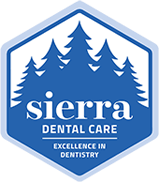
Think for a moment of an avalanche. It might start out slowly. Some snow, previously packed tightly, may buckle under the weight of snowfall accumulation, and small amounts start tumbling down the mountain. But in a short period of time, the falling snow accelerates and grows in volume — causing a serious problem for anything in its path.
Gum disease is sort of like that. It starts small, so small, in fact, that it can be easy to miss its early signs if you’re not looking for it. But untreated, the infection can cause major dental health complications, like gum recession, sensitivity, and tooth loss.
There is some good news, though. Partnering with a caring team of dental professionals, like those you’ll find at Sierra Dental Care, will increase the likelihood that gum disease will be detected early on, before it has the chance to do significant damage. And if gum disease has already taken hold of your smile, we offer gentle deep-cleaning treatments that effectively eradicate infection!
In honor of Gum Disease Awareness Month, we want to arm you with information to better spot the signs of infection. Read on to learn about five common signs of gum disease. If they sound familiar, or if you’re due for a routine checkup and cleaning, give us a call at (209) 575-2400. You’ll love the personalized care our team provides.
Sign #1: Red Or Swollen Gums
Gum disease is a bacterial infection, which explains why this is often the first sign that something’s amiss with your gums. When harmful bacteria build up along and below your gumline — often due to insufficient brushing and flossing — your immune system kicks into high gear. Blood flow to your gums increases, in the hopes that infection-fighting white blood cells will be able to restore normalcy, and this causes inflammation and reddening of the gum tissue.
At this stage, gum disease is relatively mild and is known as gingivitis. Gingivitis can sometimes be relieved with a renewed commitment to proper brushing and flossing. Antimicrobial mouthwashes can also help fight off bacteria.
In any case, seeing the dentist on a regular basis can help identify this often-missed sign of gum disease. What’s more, routine appointments every six months allow hygienists the chance to remove plaque (a sticky film of bacterial buildup) and tartar (hardened plaque) that have accumulated since your last appointment. This helps prevent gum disease.
Sign #2: Gums That Bleed When You Brush Or Floss
You should be enthusiastic about brushing and flossing, but not so much so that it crosses over into aggressive cleaning. If your gums are bleeding when you clean your teeth, it could mean you’re brushing too hard — or it could be a sign of infection.
The best course of action? Call your dentist and schedule an exam, especially if it’s been a while since your last visit. And in the meantime, pay attention to the way you brush and floss.
Sign #3: Bad Breath
Gum disease is often a result of bacterial buildup, after all, so it makes sense that bad breath could result from not brushing and flossing as often as you should be.
Bad breath can be a sign of gingivitis, but it can also occur after gum disease progresses into more advanced periodontitis. Either way, it’s not a bad idea to see your dentist to verify that gum disease is the driver of your unpleasant breath.
At Sierra Dental Care, we might recommend a deep cleaning procedure called scaling and root planing, which removes bacterial buildup from along and below your gumline. After that, we smooth out the roots of your teeth so plaque and tartar can’t easily accumulate.
Sign #4: Gum Recession
If your teeth have become sensitive to hot, cold, and sweet things, and if they’ve taken on a slightly elongated look, it’s possible that your gum tissue is receding. Although gum recession can be caused by a couple different things, periodontitis is usually to blame.
Our compassionate team can assess your periodontal pockets, and we might recommend a procedure to restore a healthy gumline.
Sign #5: Loose Or Shifting Teeth
In severe cases of gum recession, your gumline can recede so far that it actually exposes the roots of your teeth. With gum tissue no longer protecting these bony supporting structures, they become susceptible to decay — which can result in infection, shifting of the teeth, or even tooth loss.
Let’s Work Together Toward Improved Oral Health
Gum disease is extremely common. Nearly half of all adults in the U.S. are living with some form of it. But it doesn’t have to rule your life and ruin your smile.
Let’s work together to improve the health of your gums and your overall oral health! Call us at (209) 575-2400, or use our online form to request an appointment.
